Pandas fillna subset
Pandas is a powerful data manipulation library in Python, and one of its most useful features is the ability to handle missing data. The fillna() method is a key tool for dealing with missing values in pandas DataFrames. This article will explore the fillna() method in depth, with a particular focus on using it with subsets of data.
Introduction to fillna()
The fillna() method is used to fill missing values (NaN) in a DataFrame. It can be applied to the entire DataFrame or specific columns. The basic syntax is:
DataFrame.fillna(value=None, method=None, axis=None, inplace=False, limit=None)
Let’s start with a simple example to illustrate its basic usage:
import pandas as pd
import numpy as np
# Create a sample DataFrame
df = pd.DataFrame({
'A': [1, np.nan, 3, np.nan, 5],
'B': [np.nan, 2, np.nan, 4, 5],
'C': ['pandasdataframe.com', 'is', 'awesome', np.nan, 'for data analysis']
})
# Fill all NaN values with 0
filled_df = df.fillna(0)
print("Original DataFrame:")
print(df)
print("\nFilled DataFrame:")
print(filled_df)
Output:
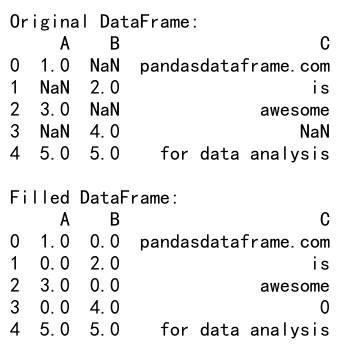
In this example, we create a DataFrame with some NaN values and then use fillna(0) to replace all NaN values with 0. This is a simple way to handle missing data, but it’s not always the most appropriate method, especially when dealing with different types of data in various columns.
Using fillna() with a dictionary
One powerful feature of fillna() is the ability to use a dictionary to specify different fill values for different columns:
import pandas as pd
import numpy as np
df = pd.DataFrame({
'A': [1, np.nan, 3, np.nan, 5],
'B': [np.nan, 2, np.nan, 4, 5],
'C': ['pandasdataframe.com', 'is', 'awesome', np.nan, 'for data analysis']
})
# Fill NaN values with different values for each column
filled_df = df.fillna({
'A': 0,
'B': -1,
'C': 'Unknown'
})
print("Original DataFrame:")
print(df)
print("\nFilled DataFrame:")
print(filled_df)
Output:
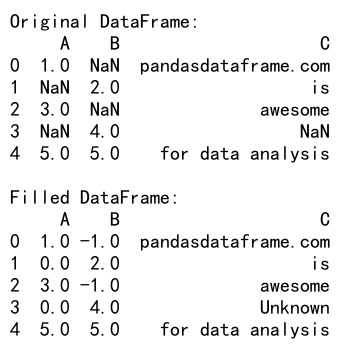
In this example, we use a dictionary to specify different fill values for each column. Column ‘A’ is filled with 0, ‘B’ with -1, and ‘C’ with the string ‘Unknown’. This approach allows for more nuanced handling of missing data based on the nature of each column.
Using fillna() with a Series
You can also use a Series to fill NaN values, which can be particularly useful when you want to fill values based on some calculation or condition:
import pandas as pd
import numpy as np
df = pd.DataFrame({
'A': [1, np.nan, 3, np.nan, 5],
'B': [np.nan, 2, np.nan, 4, 5],
'C': ['pandasdataframe.com', 'is', 'awesome', np.nan, 'for data analysis']
})
# Create a Series with fill values
fill_values = pd.Series([10, 20, 'pandasdataframe.com rocks'], index=['A', 'B', 'C'])
# Fill NaN values using the Series
filled_df = df.fillna(fill_values)
print("Original DataFrame:")
print(df)
print("\nFilled DataFrame:")
print(filled_df)
Output:
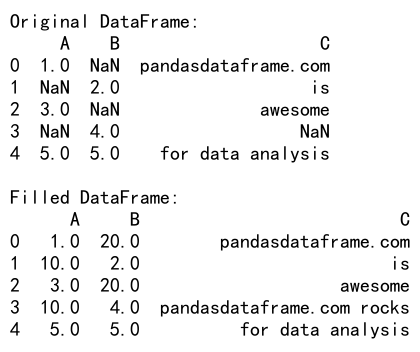
In this example, we create a Series with specific fill values for each column and use it to fill the NaN values in the DataFrame. This method allows for even more flexibility in how we handle missing data.
Using fillna() with a callable
You can also use a callable (function) with fillna() to determine the fill value dynamically:
import pandas as pd
import numpy as np
df = pd.DataFrame({
'A': [1, np.nan, 3, np.nan, 5],
'B': [np.nan, 2, np.nan, 4, 5],
'C': ['pandasdataframe.com', 'is', 'awesome', np.nan, 'for data analysis']
})
# Define a function to generate fill values
def fill_func(col):
if col.dtype == 'object':
return 'pandasdataframe.com - Missing'
else:
return col.mean()
# Fill NaN values using the function
filled_df = df.fillna(fill_func)
print("Original DataFrame:")
print(df)
print("\nFilled DataFrame:")
print(filled_df)
Output:

In this example, we define a function that returns different fill values based on the column’s data type. For numeric columns, it uses the mean of the column, and for object (string) columns, it uses a custom string.
Using fillna() with subset and multiple fill methods
You can apply different fill methods to different subsets of columns in a single operation:
import pandas as pd
import numpy as np
df = pd.DataFrame({
'A': [1, np.nan, np.nan, np.nan, 5],
'B': [np.nan, 2, np.nan, 4, 5],
'C': ['pandasdataframe.com', 'is', 'awesome', np.nan, 'for data analysis'],
'D': [np.nan, np.nan, np.nan, np.nan, np.nan]
})
# Apply different fill methods to different subsets
filled_df = df.fillna({
'A': df['A'].ffill(),
'B': df['B'].bfill(),
'C': 'pandasdataframe.com - Unknown'
})
print("Original DataFrame:")
print(df)
print("\nFilled DataFrame:")
print(filled_df)
Output:
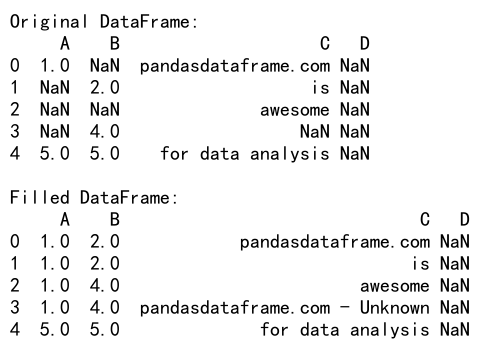
In this example, we apply forward fill to column ‘A’, backward fill to column ‘B’, and fill with a constant string to column ‘C’, all in a single operation.
Using fillna() with subset and conditional logic
You can use conditional logic to determine how to fill NaN values in specific subsets:
import pandas as pd
import numpy as np
df = pd.DataFrame({
'A': [1, np.nan, 3, np.nan, 5],
'B': [np.nan, 2, np.nan, 4, 5],
'C': ['pandasdataframe.com', 'is', 'awesome', np.nan, 'for data analysis'],
'D': [np.nan, np.nan, np.nan, np.nan, np.nan]
})
# Define a function with conditional logic
def conditional_fill(col):
if col.name in ['A', 'B']:
return col.fillna(col.mean())
elif col.name == 'C':
return col.fillna('pandasdataframe.com - Missing')
else:
return col
# Apply conditional fill to all columns
filled_df = df.apply(conditional_fill)
print("Original DataFrame:")
print(df)
print("\nFilled DataFrame:")
print(filled_df)
Output:
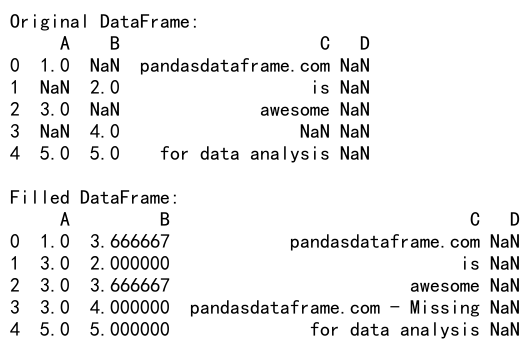
In this example, we define a function that applies different fill methods based on the column name. We then use apply() to apply this function to all columns in the DataFrame.
Using fillna() with subset and external data sources
Sometimes, you might want to fill NaN values with data from an external source. Here’s an example of how to do this:
import pandas as pd
import numpy as np
# Main DataFrame
df = pd.DataFrame({
'A': [1, np.nan, 3, np.nan, 5],
'B': [np.nan, 2, np.nan, 4, 5],
'C': ['pandasdataframe.com', 'is', 'awesome', np.nan, 'for data analysis'],
'D': [np.nan, np.nan, np.nan, np.nan, np.nan]
})
# External data source
external_data = pd.DataFrame({
'A': [10, 20, 30, 40, 50],
'B': [15, 25, 35, 45, 55],
'C': ['external1', 'external2', 'external3', 'external4', 'external5']
})
# Fill NaN values with external data
filled_df = df.copy()
for col in ['A', 'B', 'C']:
filled_df[col] = filled_df[col].fillna(external_data[col])
print("Original DataFrame:")
print(df)
print("\nExternal Data:")
print(external_data)
print("\nFilled DataFrame:")
print(filled_df)
Output:
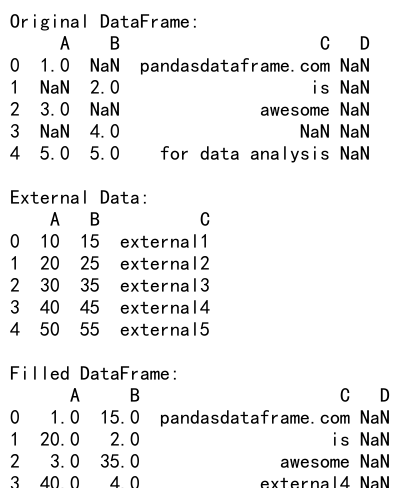
In this example, we have an external data source that we use to fill NaN values in our main DataFrame. We iterate through the columns we want to fill and use the corresponding column from the external data source.
Pandas fillna subset Conclusion
The fillna() method in pandas is a powerful tool for handling missing data, and its ability to work with subsets of data makes it even more versatile. By using the subset parameter along with various other parameters and techniques, you can create sophisticated data cleaning and imputation strategies tailored to your specific needs.
Some key points to remember:
- The
subsetparameter allows you to applyfillna()to specific columns, giving you fine-grained control over how missing data is handled. - You can combine
subsetwith other parameters likemethod,limit, andinplacefor more complex fill operations. - Custom functions and conditional logic can be used with
fillna()andsubsetto create very specific fill strategies. fillna()can be combined with other pandas operations likegroupby()for even more powerful data manipulation.- When working with time series or multi-index DataFrames,
fillna()with subset can be particularly useful for handling missing data in specific groups or levels.
By mastering these techniques, you’ll be well-equipped to handle missing data in a variety of scenarios, ensuring that your data analysis and machine learning projects are built on a solid foundation of clean, well-prepared data.
 Pandas Dataframe
Pandas Dataframe